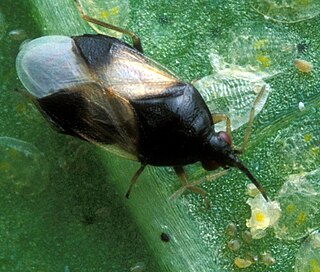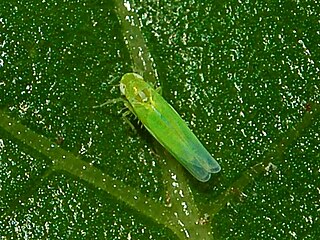
Hemiptera is an order of insects, commonly called true bugs, comprising over 80,000 species within groups such as the cicadas, aphids, planthoppers, leafhoppers, assassin bugs, bed bugs, and shield bugs. They range in size from 1 mm (0.04 in) to around 15 cm (6 in), and share a common arrangement of piercing-sucking mouthparts. The name "true bugs" is often limited to the suborder Heteroptera.

The glassy-winged sharpshooter is a large leafhopper, similar to other species of sharpshooter.

The silverleaf whitefly is one of several species of whitefly that are currently important agricultural pests. A review in 2011 concluded that the silverleaf whitefly is actually a species complex containing at least 40 morphologically indistinguishable species.

A leafhopper is the common name for any species from the family Cicadellidae. These minute insects, colloquially known as hoppers, are plant feeders that suck plant sap from grass, shrubs, or trees. Their hind legs are modified for jumping, and are covered with hairs that facilitate the spreading of a secretion over their bodies that acts as a water repellent and carrier of pheromones. They undergo a partial metamorphosis, and have various host associations, varying from very generalized to very specific. Some species have a cosmopolitan distribution, or occur throughout the temperate and tropical regions. Some are pests or vectors of plant viruses and phytoplasmas. The family is distributed all over the world, and constitutes the second-largest hemipteran family, with at least 20,000 described species.

Aster yellows is a chronic, systemic plant disease caused by several bacteria called phytoplasma. The aster yellows phytoplasma (AYP) affects 300 species in 38 families of broad-leaf herbaceous plants, primarily in the aster family, as well as important cereal crops such as wheat and barley. Symptoms are variable and can include phyllody, virescence, chlorosis, stunting, and sterility of flowers. The aster leafhopper vector, Macrosteles quadrilineatus, moves the aster yellows phytoplasma from plant to plant. Its economic burden is primarily felt in the carrot crop industry, as well as the nursery industry. No cure is known for plants infected with aster yellows. Infected plants should be removed immediately to limit the continued spread of the phytoplasma to other susceptible plants. However, in agricultural settings such as carrot fields, some application of chemical insecticides has proven to minimize the rate of infection by killing the vector.

The beet leafhopper, also sometimes known as Neoaliturus tenellus, is a species of leafhopper which belongs to the family Cicadellidae in the order Hemiptera.

Adelphocoris lineolatus, is commonly known as the Lucerne bug or the alfalfa plant bug, and belongs to the family Miridae. It is an agricultural pest causing vast amounts of damage to numerous crops, but primarily to alfalfa crops around the globe.

Myzus persicae, known as the green peach aphid, greenfly, or the peach-potato aphid, is a small green aphid belonging to the order Hemiptera. It is the most significant aphid pest of peach trees, causing decreased growth, shrivelling of the leaves and the death of various tissues. It also acts as a vector for the transport of plant viruses such as cucumber mosaic virus (CMV), potato virus Y (PVY) and tobacco etch virus (TEV). Potato virus Y and potato leafroll virus can be passed to members of the nightshade/potato family (Solanaceae), and various mosaic viruses to many other food crops.

The common brown leafhopper is one of the most common species of Australian leafhoppers with a very wide host range. It is an important vector of several viruses and phytoplasmas worldwide. In Australia, phytoplasmas vectored by O. orientalis cause a range of economically important diseases including legume little leaf, tomato big bud, lucerne witches broom, potato purple top wilt, Australian lucerne and the insect is a possible vector of Australian grapevine yellows. O. orientalis also transmits Tobacco yellow dwarf virus to beans, causing bean summer death disease and to tobacco, causing tobacco yellow dwarf disease.

Orius insidiosus, common name the insidious flower bug, is a species of minute pirate bug, a predatory insect in the order Hemiptera. They are considered beneficial, as they feed on small pest arthropods and their eggs. They are mass-reared for use in the biological control of thrips.

The black bean aphid is a small black insect in the genus Aphis, with a broad, soft body, a member of the order Hemiptera. Other common names include blackfly, bean aphid, and beet leaf aphid. In the warmer months of the year, it is found in large numbers on the undersides of leaves and on the growing tips of host plants, including various agricultural crops and many wild and ornamental plants. Both winged and wingless forms exist, and at this time of year, they are all females. They suck sap from stems and leaves and cause distortion of the shoots, stunted plants, reduced yield, and spoiled crops. This aphid also acts as a vector for viruses that cause plant disease, and the honeydew it secretes may encourage the growth of sooty mould. It breeds profusely by live birth, but its numbers are kept in check, especially in the later part of the summer, by various predatory and parasitic insects. Ants feed on the honeydew it produces, and take active steps to remove predators. It is a widely distributed pest of agricultural crops and can be controlled by chemical or biological means. In the autumn, winged forms move to different host plants, where both males and females are produced. These mate and the females lay eggs which overwinter.

Empoasca decipiens is a species of leafhopper belonging to the family Cicadellidae subfamily Typhlocybinae. The adults reach 3–4 millimetres (0.12–0.16 in) of length and a are homogenously green with whitish markings on its pronotum and vertex. E. decipiens is commonly referred to as the “green leafhopper” because of its colouration. The absence of clear stripes along the forewings can easily distinguish it from the similar leafhopper species E. vitis, but distinguishing it from other leafhoppers with the same colouration requires examination under a microscope. It is present in most of Europe, in the eastern Palearctic realm, in North Africa, in the Near East, and in the Afrotropical realm. Both nymphs and adults of this small insect are considered to be a very destructive pests on field crops, vegetables and greenhouse plants.

Peregrinus maidis, commonly known as the corn planthopper, is a species of insect in the order Hemiptera and the family Delphacidae. It is widespread throughout most tropical and subtropical regions on earth, including southern North America, South America, Africa, Australia, Southeast Asia and China. P. maidis are a commercially important pest of maize and its relatives. In addition to physical plant damage, P. maidis is the vector for several species-specific maize viruses, including maize stripe virus, maize mosaic virus and the non-pathogenic Peregrinus maidis reovirus.
Empoasca decedens is a species of leafhoppers belonging to the family Cicadellidae. This species has a small, slender body with a yellowish green coloration. Both males and females measure between 3.1 to 3.3 millimetres in length.

Rhopalosiphum rufiabdominale, the rice root aphid or red rice root aphid, is a sap-sucking insect pest with a wide host range and a global distribution. As a member of the superfamily Aphidoidea, it is one of 16 species of the genus Rhopalosiphum. Adults and nymphs are soft-bodied and usually dark green with brown, red, or yellow tones. Like all aphids, reproduction is sexual and asexual, depending on the environmental conditions and host plant. Rice root aphids cause injury to external plant parts, namely the roots or stem, by feeding on plant sap and vector several important plant viruses. The hosts of this pest extend across multiple plant families with most belonging to Rosaceae, Poaceae, and Solanaceae. R. rufiabdominale is universally associated with Prunus species but also infests various field crops, greenhouse vegetables, cannabis, and other ornamental plants. While this aphid originates from east Asia, it spans nearly every continent. Dispersal is particularly widespread across the United States, India, and Australia, with crop damage documented in multiple instances, although economic losses are primarily associated with Japanese rice crops. Nonetheless, it remains a pest of serious concern due to its high mobility, discrete habitat, and adaptive plasticity, giving it the rightful reputation as a successful invader.

Corn stunt disease is a bacterial disease of corn and other grasses. Symptoms include stunted growth and leaves turning red. It is caused by the bacterium Spiroplasma kunkelii.

Sitona lineatus, commonly known as the pea leaf weevil is a species of weevil with a Palearctic distribution. It is a common pest of beans, peas, and other plants in the family Fabaceae. Adult beetles of S. lineatus measure 3.4-5.3 mm in length. They are characterized by a series of colored scales arranged in alternating lines (striae) on the elytra; it is from this characteristic where the species gets its name lineatus meaning 'lined' or 'striped'. The head and pronotum also have fine pointed setae amongst the scales. The antennae are clubbed, pointed and preceded by 7 segments. The femora is dark, but tibiae and tarsi are red. As a member of Order Coleoptera (beetles) their forewings are modified to form hardened covers over the thorax and abdomen, with the hindwings for flight underneath.

Aleurocanthus spiniferus, the citrus spiny whitefly, is an important pest of citrus and tea plants. They are part of the order Hemiptera, and the family Aleyrodidae, where more than 1550 species have been described. A. spiniferus is indigenous to parts of tropical Asia, where it was first discovered in Japan. Since its discovery, it has now spread to numerous continents including Africa, Australia, America, Pacific Islands and Italy. Wherever it is found, it has become a highly destructive pest. Two populations of A. spiniferus have been found according to the plant or crop they infest: the citrus spiny whitefly, as well as the tea spiny whitefly.
Amrasca biguttula, commonly known as the cotton jassid, is a subspecies of leafhopper belonging to the subfamily Typhlocybinae of family Cicadellidae. It is a pest of cotton, okra, and other crops in southern Asia and West Africa.

Erasmoneura vulnerata is a species of leafhopper native to North America. The species was found to be in Europe in 2004 where it causes significant economic damage to grapevine yards. E. vulnerata is commonly found on wild and cultivated grapes from both continents. Its Latin name translates to "wounded Erasmoneura" from its original description.




















